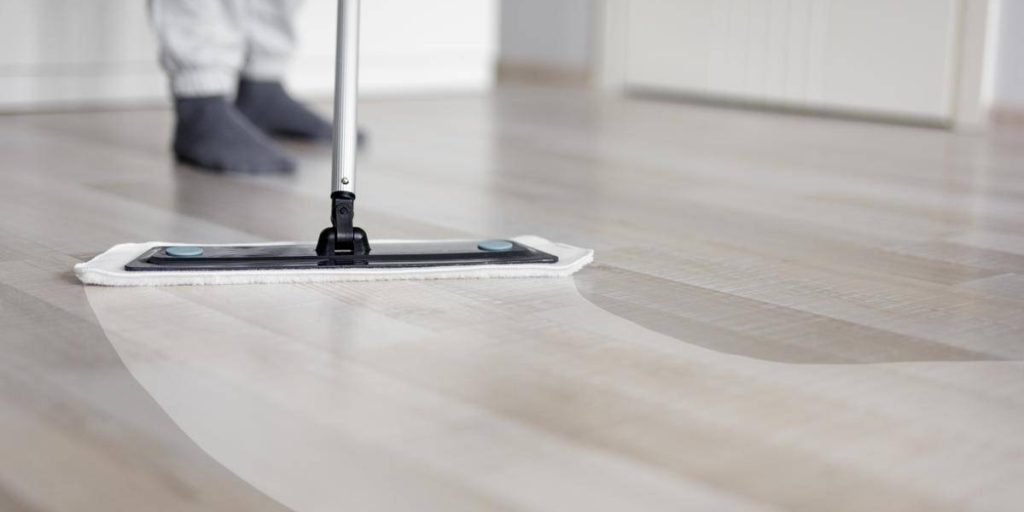How to Mop Different Types of Flooring

We like to beautify our houses with different types of laminate, tiles, or hardwood flooring. While they look impressive, they also need proper care. While the above instructions tell you how to mop a floor properly, some flooring may have special requirements. Read on to find out special cleaning needs for different types of flooring used at homes.
1. Laminate Flooring
While laminates may imitate the appearance of stone or hardwood, you will still need to care for them as laminates. As they are made with sun and light resistant materials, they don’t get damaged easily. While mopping a laminate floor you must avoid water from getting underneath the planks. Expert house cleaners suggest that you vacuum clean the floor and dry mop once a week.
You may spot clean the stubborn areas with a damp mop but don’t use too much water. If a plank looks damaged, resist your temptation of polishing the floor. It is better to replace the damaged plank with a new one.
2. Hardwood Flooring
The hardwood flooring typically come in two finishes – wax and polyurethane. The sealed wood floorings may have a polyurethane, urethane, or polyacrylic coating that prevents water damage and stains. To mop hardwood floors, mix a ¼ cup of mild soap in a bucket of water and damp mop with a microfiber cloth to prevent excess moisture.
Hardwood floorings do not require a lot of maintenance. Just sweeping and vacuum cleaning every 2-3 days may be enough. Mop the high-traffic areas of the house once a week and the remaining you can do just once a month.
If you have waxed floors then mopping is out of questions. This type of floor can be easily damaged by water so keep the damp mops away. I would recommend that you sweep frequently, dust mop and vacuum once a week to keep the floor clean.
3. Cork Flooring
Floor made of natural cork look appealing due to its porosity but the same characteristic makes it vulnerable to water. As the material is highly absorbent, most cork flooring is sealed on the top but you still need to be careful.
Cleaning experts recommend vacuuming the clean cork flooring to prevent scratching. Wipe any spills immediately so that the floor does not absorb the liquid and mop once a week. To clean the flooring, use a solution made of a ¼ cup of vinegar and a little liquid dish soap.
Vinegar has an acidic quality which works with the soapy solution to break down the stubborn dirt and sanitize the floor. Don’t shake the solution vigorously as this may create suds. Gently mix the solution in a spray bottle. Spray the solution on one section at a time and mop with a damp microfiber.
4. Vinyl Flooring
Weekly cleaning is enough to keep your vinyl flooring well maintained and clean. I recommend the spray and dry mop technique to clean the dirty tiles. Mix warm water with a ¼ cup of vinegar and a drop of dish soap in a spray bottle. Spray the solution on the floor and clean with a damp cloth as you go.
To deep clean the floor, you may use a steam cleaner to get rid of the stubborn dirt or stains in the tile and grout. The steam not only loosens up the clogged dirt but also kills the bacteria.
5. Natural Stone Flooring
This type of flooring is extremely sensitive to acidic cleaning solutions, so never use vinegar to mop the floor. Even a small amount of vinegar, ammonia, or bleach could damage the surface. I recommend using only pH-neutral cleaners that would not react to the minerals in these surfaces.
If the stone flooring is unsealed, only use a damp mop to clean the surface and avoid any type of chemicals as they can damage the stone. Use a steam cleaner to get rid of the stubborn dirt.
6. Bamboo Flooring
Bamboo flooring is beautiful and highly sustainable. However, in some cases, they may be softer and more vulnerable to scratches and nicks. The strand bamboo flooring is the most durable of all but you will still need to be extra careful when sweeping dirt and debris.
To clean the bamboo floor, use the same cleaning mix – a ¼ cup of mild soap in a bucket of water. Clean the floor using a barely damp mop and keep a dry microfiber cloth handy to absorb any excess moisture.
7. Linoleum Flooring
This type of artificial flooring is made from a mixture of wood fiber, cork dust, linseed oil, resin, and limestone. Mineral pigments are used as coloring agents. To mop a linoleum floor, fill hot water in a spray bottle and add a few drops of dish soap to it.
Spritz on the floor, one section at a time, and then wipe with a damp cloth or microfiber mop. Make sure the floor air-dries immediately after you finish mopping. If it feels sticky to touch then mop once again with a clean damp cloth to get rid of any soapy residue.
8. Porcelain Tile Flooring
To keep your porcelain tile floor looking primp and proper, it’s enough to clean weekly using the spray and mop technique. In a spray bottle, mix together warm water, 1/4 cup vinegar and a drop of dishwasher soap. Spray one section of the floor at a time and wipe with a damp cloth.
For periodic deep cleaning, you may use a steam cleaner to remove dirt, grime, and stains from tiles and grouts. It not only cleans the floor but sanitizes too!








